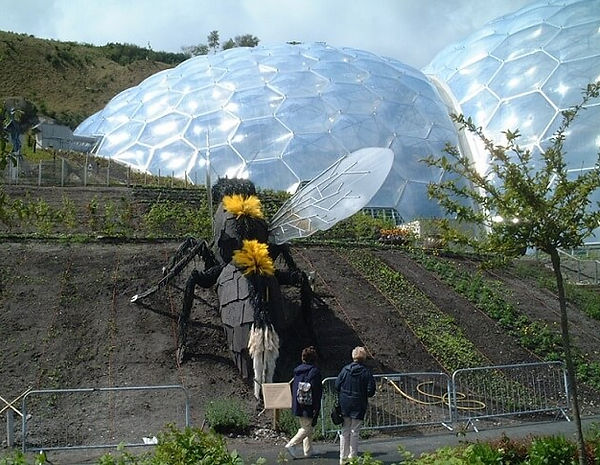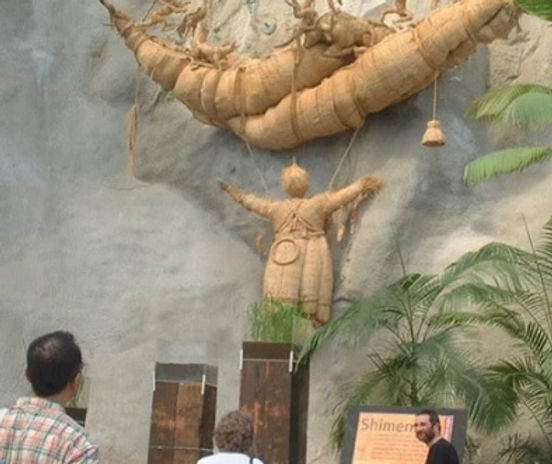The world of Paul Spooner
1. 1. Worries about the global environment
Until now, Paul Spooner's evaluation in Japan has been treated as an excellent "automata craftsman" at best.
However, in recent years, more and more people have begun to realize that he is not just a “craftsman”.
The development of SNS may have begun to shed light on his talent.
Of course, as a prelude to that phenomenon, people who visited exhibitions all over the country felt their talents by touching Paul Spooner's modeling, drawing, photography, writing, etc. I have had it.
The mysterious sensation that the movements and sounds produced by the complicated mechanism of the automata are mixed with the human view surrounded by humor and irony has begun to appear fresh to us living in the present age.
Frequent international conflicts caused by environmental problems, immigration, religion, idealism, etc. Ironically, the daily living environment that has become difficult to live in, such as a serious population decline, widening economic disparity, imports of labor from overseas, and a generation gap, is shortening the distance from "Paul Spooner World". maybe.
I would like to move the topic to the huge complex environmental facility "Eden Project" in Cornwall, England. This is because he has a close relationship with Paul Spooner, and there are many clues to know the idea behind his work.
In fact, many of his works have been installed in various places since the establishment of this facility, and there is even a special corner for him at the entrance, so you can see the depth of the relationship.

.jpg)
.jpg)

Let me explain a little about the Eden Project here.
This "museum" collects more than 100,000 species of plants from all over the world.
What's more, it's not just a so-called botanical garden where plants are lined up, but it's unprecedented in the world that has realized the theme of "The Living theater of plants and people." ..

The living ecosystem itself is produced in the world's largest dome called biome (biome system), and there is a waterfall in the dome group that is 50 meters high and 1 km long. There are many small farmlands and rice fields, and small animals live in the forest, and you can see mushrooms from the decaying trees.
With a catch phrase, "Please see us grow up," this museum seems to symbolize the basic idea of a growing museum.
.jpg)
The Cornwall Peninsula, on the edge of the eastern part of England, is famous for its rich English villas and many artists, probably because of the warm climate reminiscent of the Mediterranean Sea and the beautiful old-fashioned cityscape. Is also the place to set up an atelier in this place.
The Eden Project is a collaboration of locals, botanists, artists and their patrons.
Compared to London's Tate Modern and the London Eye Ferris wheel, this "museum" may surpass them in terms of fun, future potential, and social significance.


Paul Spooner's works often feature "Dodo birds" as a motif.
The Dodo bird seems to have been salted after being captured and used as a preserved food for sailors.
The work "The Last Dodo Bird" depicts the fate of the last bird just before extinction.
Whether it's the last one or not, it doesn't matter to the hungry sailors.
Just saying, "Let's eat it quickly", it is funny to see how he waits with a knife and fork at the table in both hands.

Let's get back to the Eden Project. I told you that Paul Spooner's "life-sized puppet theater corner" is set up at the entrance.
There, as a result of seeking a balance between supply and demand of food due to the increase in the world's population, environmental destruction will progress, food safety will not be ensured, and even milk will not be safe ... It is performed by life-sized dolls.


The source of the cats that appear there is this work called "damaged milk."
A cat with a lovely expression. I keep licking milk innocently, but "at that time" comes suddenly.
On the contrary, the abruptness is real and makes you feel the fear close to you.
It is one of the works that can be said to have been successful in the direction and effect of the author.
The illustration below is an image sketch of the work. The other is Paul Spooner, who explains to the author how the compressor is used at the entrance "theater" back in the Eden Project.


The third point is to explain "a man who eats spaghetti".
It's strange that a man can use a fork to bring pasta full of bathtub to his mouth by turning the handle, but it's a funny work for some reason.
If you look closely, you can't miss the details of pasta and pasta sauce coming out of the two jacuzzis. Pasta and pasta sauce will continue to come out forever while the handle is turning, but this is not a reality.
You realize that food resources are finite, but it depicts the time to discuss this issue.

Heading 6
2. Respect for foreign cultures
The original title is "An Allegory of Love".
It was created with the motif of "Agnolo Gaddi's painting" at the National Gallery in London.
So far, the painting has been interpreted in various ways. For example, "a moral lesson of the Counter-Reformation era that expresses a warning against love drowning in earthly pleasures" ... is predominant, but it's difficult.
Paul Spooner, on the other hand, created this work using the following interpretation.
"A mysterious painting that does not bring about a philosophical interpretation loses harmony between the meaning itself and the depiction, and there is a fierce twist between the two, thus giving a double impression."
The point is, to the person who is trying to hit the nail, "It is life that the nail is twisted and does not go as expected, but rather the other person is a nail, so this is enough (I hurt my finger). Human beings. I'm glad it wasn't a relationship. "

.jpg)
Next is a work called "Kawabuta".
The author did not ridicule the people (Japanese) who understand this work as a poisonous fish and eat it. Rather, what is the trend of looking down on multi-ethnic food culture? It is expressed as.
British people have a habit of eating smoked herring. It has a poisonous orange color called Kipper.
The origin of the poisonous color is attributed to the coloring to cut the cost of manufacturing.
The author has added the following notes to this work.
"Don't call the other country's food culture of eating blowfish stupid, knowing that it's poisonous, because it's just a prejudice."
As I mentioned earlier, the British people continue to eat, even though they know that smoked coloring is toxic ... That's right.

Heading 6
3. 3. The absurdity of life
Paul Spooner has a lot of works on the theme of "absurdity of life", and I feel that knowing the truth deepens the impression because it looks cute and innocent.
For example, isn't this work "The Mill-Girl and Toff" one of the easy-to-understand examples?
The original title is "Spinning Mill Female Worker and Soshi". The background of the times is around the time of the Industrial Revolution.
A sergeant who fell in love with a female worker who works at his father's company.
Get bored with gold and propose with diamonds.
The female worker is so surprised that the eyeballs pop out. A picture-perfect Cinderella story,
In other words, it's a ball.
However, if you look closely, you can see that two cams are spinning at their feet.
Further observing, the two cams have the shape of a coffin.
No, it's the casket itself. "Hmm, I see. Marriage is a graveyard of life."
The person who thinks is a person with a keen intuition.
However, Paul Spooner World was still ahead.
The two caskets. I will make further observations.
One is a fine item made from high-grade mahogany. It even has a crown.
The other is Shiraki's cheap food. Isn't it carefully written on the back that "a person without a name"?
A glimpse of the rigors of British class society ...




Heading 6
Four. Word play
Paul Spooner often incorporates wordplay into his work.
This work called "Kumaneko" is one of them, and it is actually an anagram.
The original title is "Bearcat"
If you replace the letters, "Cabaret"
The author who produced (sold) works for the permanent building "Cabaret Mechanical Theater" of Automata in Covent Garden, London until about 10 years ago.
You already know.
The relationship between the manager and the writer was likened to a parent-child cat, which is the motif of the work.
Ms. Sue Jackson, the owner at the time, asked the hot-selling author Paul Spooner to produce a number of works. CMT (Cabaret Mechanical Theata) has Fushi who thought that there was a life of an automata writer such as Paul because the company management is doing well.
However, Paul Spooner took that as a counter-product and put the message, "The reality is the opposite. In other words, the writer supports the management of CMT" in this work. Sue Jackson knew that, though.
This work, which hides an uncertain relationship between the two, like a word game whose meaning changes by exchanging letters, has since become a symbol of CMT and is entertaining us.

5.ブラックユーモアではない
ここが肝心なのですが、ポール・スプーナーのユーモアは、ブラックコメディとは対照的です。痛烈な批判というよりは、むしろ皮肉めいた内なる微笑に近く、
他者を嘲笑するのではなく、アーティストと観客の両方を、私たち自身も含めた人間のあり方を静かに見つめ直すという、共通の行為へと誘う。
それは、切ない情感を帯びた穏やかなユーモアの感覚を伴う。この意味で、彼の「メカニカル・ジョーク」は残酷でも嘲笑的でもなく、共感的で内省的な性質を持つ。嘲笑するのではなく、明らかにするユーモアなのです。
次にご紹介するのは、世界的にも名高いスイスのミシンブランド「ベルニナ(Bernina)」をモチーフとした作品です。
スイスのポール・グーゲルマン博物館で開催された展覧会場は、「機械仕掛けの芸術を深く愛する人々が集う場」として知られています。
その際、ポール・スプーナーは「スイスの文化や職人技に根ざしたテーマであれば、地元の観客により強く響くだろう」と考えたようで、選んだのは、世界的にも名高いスイスのミシンブランド「ベルニナ(Bernina)」でした。
スプーナーの狙いは、こうした選択によってスイスの観客に誇りや親しみを喚起できる、という点にあったようです。
スプーナーらしい機知に富んだ、そしてどこかユーモラスな発想でした。「外国のブランドよりも、スイス製のミシンを題材とした作品の方が観客の心に響き、ひいては受け入れられる可能性も高いだろう」と。
*ベルニナ(Bernina)製のミシンが動きだすと、内側から三人のお針子が登場する仕掛けです。